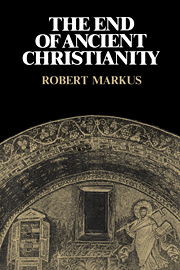Book contents
- Frontmatter
- Contents
- Preface
- Abbreviations
- 1 Introduction: ‘secularity’
- I The crisis of identity
- II Kairoi: Christian times and the past
- 6 The last times
- 7 The martyrs and sacred time
- 8 Secular festivals in Christian times?
- 9 The christianisation of time
- III Topoi: space and community
- Sources referred to
- Secondary literature referred to
- Index
9 - The christianisation of time
Published online by Cambridge University Press: 05 June 2012
- Frontmatter
- Contents
- Preface
- Abbreviations
- 1 Introduction: ‘secularity’
- I The crisis of identity
- II Kairoi: Christian times and the past
- 6 The last times
- 7 The martyrs and sacred time
- 8 Secular festivals in Christian times?
- 9 The christianisation of time
- III Topoi: space and community
- Sources referred to
- Secondary literature referred to
- Index
Summary
In the last chapter we examined the co-existence of Christian and non-Christian in a civic setting, the pressures to which it was exposed, and the various ways in which it could survive or break down. In the end, however, this diversity was smoothed out into a uniformity spreading over Christian Western Europe. What we have seen happening in some of the smaller towns of North Africa with a fairly homogeneous Christian population was to set the pattern for the future. In such places the clergy could impose their norms without much difficulty. Religion swallowed up the secular civic consensus, citizenship merged with membership of the community of the faithful, and municipal affairs came to be dominated by the Church.
Rome, though always a law unto itself, underwent a development very similar to what happened in the tiny town of Simittu. The City's history in Late Antiquity is dominated by the disproportion between the supreme place it continued to occupy in educated Roman imaginations, and the comparatively unimportant part it played in the political and economic life of the Empire. This paradox facilitated its premature emergence as a Christian city. Its bishops were precociously energetic in exploiting the possibilities that they perceived for turning their city into the head and centre of the Christian world, the ancient capital renewed by its two martyr-Apostles and re-born as a Christian Rome.
- Type
- Chapter
- Information
- The End of Ancient Christianity , pp. 125 - 136Publisher: Cambridge University PressPrint publication year: 1991



